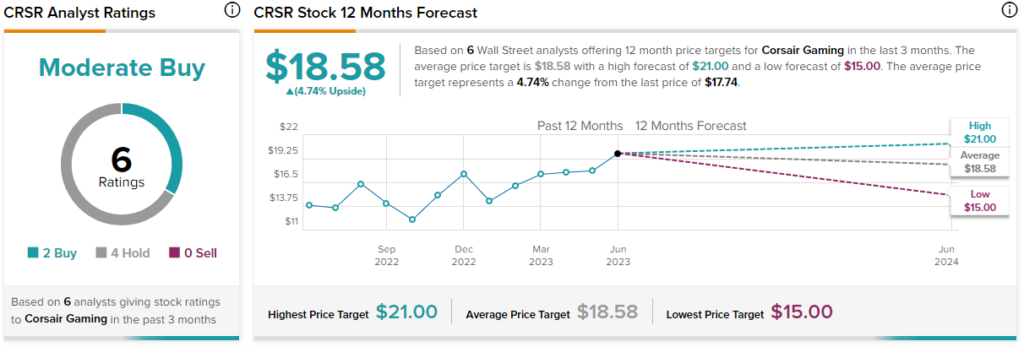Corsair Gaming stock (NASDAQ:CRSR) has recovered nicely from last year’s lows, gaining nearly 30% over the past year. The post-pandemic investor pessimism surrounding PC hardware stocks eased, allowing the company to trade at a higher valuation multiple in recent months. That said, I find its weak profits to be a headwind for further gains.
Stay Ahead of the Market:
- Discover outperforming stocks and invest smarter with Top Smart Score Stocks
- Filter, analyze, and streamline your search for investment opportunities using Tipranks' Stock Screener

On the one hand, Corsair holds a competitive edge in its industry, which could result in continuous revenue growth. In fact, I believe that due to its unique qualities, Corsair stock makes for one of the better investment options within its brutally-competitive space.
On the other hand, I am worried about Corsair’s narrow profit margins, posing challenges for the company to achieve substantial profits. This notion, combined with the fact that Corsair stock appears to be trading at a premium valuation, makes me eager to shift my rating from a bullish one to neutral.
A Strong Investment Option for Industry Exposure
While I have a hard time remaining bullish on Corsair stock, given its current financial position and outlook, I do believe that the company is generally a strong investment option for someone who wants exposure to the PC and gaming equipment and peripherals space. This noteworthy aspect deserves attention, especially in light of the prevailing frenzy surrounding AI and semiconductor stocks, which could result in a significant transfer of pricing power to PC hardware companies.
In this scenario, I believe that Corsair stands at the forefront, perfectly positioned to harness the rewards of a remarkable super-cycle within the cyclical nature of its industry. This is because of its competitive edge. Corsair stands as a dominant force in the computer-gear industry, having maintained its position as a key player for over two decades.
Notably, the company holds an enviable #1 market share in various product categories within the United States. Corsair’s market dominance is particularly striking in the gaming realm, with an impressive 46% share in gaming components and an astounding 72% share in the gaming memory market. These figures have seen a substantial increase from their previous range of 30% to 40% around five years ago, serving as a testament to Corsair’s consistent innovation and commitment to fortifying its consumer brand.
This concept is particularly why I am generally optimistic about the company’s prospects in an ever-evolving computing space. Corsair’s remarkable ability to establish a reputation for genuine, high-end engineering in this challenging environment sets it apart. Such a reputation has enabled the company to maintain a loyal customer base, providing a significant competitive advantage and continuously enhancing its leading market position over time, as it has undeniably achieved in recent years.
Weak Margins Struggle to Produce Substantial Profits
Corsair’s margins have been rather weak lately due to the company experiencing somewhat soft sales. Hence, Corsair has a hard time producing substantial profits. In its most recent fiscal Q1 results, net revenues landed at $354.0 million, 7% lower year-over-year.
Note that the decline in sales follows a normalization from the company’s record 2021 revenues which had been inflated due to higher demand for PC hardware during the pandemic. For context, in Q1 2022, net revenues were $380.7 million, while in Q1 2021, in the midst of the pandemic, the company recorded net revenues of $529.4 million.
That said, despite the gradual normalization from the pandemic-driven demand of two years ago, this year’s Q1 net revenues were notably higher than the pre-pandemic’s Q1-2020 net revenues of $308.5 million. Hence, you can see the company’s gradual growth and market share gains trend, excluding 2021-22’s frenzy.
The issue here is that while Corsair’s revenues have grown on a three-year basis, its expenses have expanded much faster, mainly due to inflationary pressure and raw material costs associated with producing its hardware. Hence, the company’s profit margins have been compressed significantly.
In its most recent results, Corsair’s operating margin came in at just 0.3%. Then, when accounting for other non-operating expenses, such as interest expenses, Corsair’s net income margin for the quarter was actually negative, at -0.6%.
Unless demand for PC hardware jumps and Corsair’s pricing power rises (which could occur, as previously mentioned), it’s quite likely that Corsair’s margins will result in soft losses or break-even results for the company, at best, which is undoubtedly concerning regarding the stock’s future.
Is CRSR Stock a Buy, According to Analysts?
Turning to Wall Street, Corsair Gaming has a Moderate Buy consensus rating based on two Buys and four Hold ratings assigned in the past three months. At $18.58, the average Corsair Gaming stock price target implies 4.74% upside potential.

Final Thoughts
Corsair Gaming stock presents a mixed picture for investors. While the company holds a competitive edge in the PC hardware industry and stands well-positioned for growth, its weak profit margins pose a significant challenge. The company’s recent financial results indicate a struggle to generate substantial profits, largely due to soft sales and rising expenses.
In fact, consensus estimates for Corsair’s Fiscal 2023 point to earnings per share of just $0.60. It’s a significant improvement from last year, as Wall Street expects the company’s performance to pick up in the latter part of the year.
Still, this estimate implies that shares are trading at a premium forward P/E ratio of 29.7. This is a very pricy multiple for a company that operates in a cyclical industry while struggling to achieve meaningful margins.
Unless Corsair’s earnings grow by two to three times within the next couple of years, it should be very hard for the stock to sustain its current price levels, given investors’ obvious expectations for significant earnings growth ahead. Therefore, I believe that investors have a very thin safety net against the possibility of notable downside ahead.









